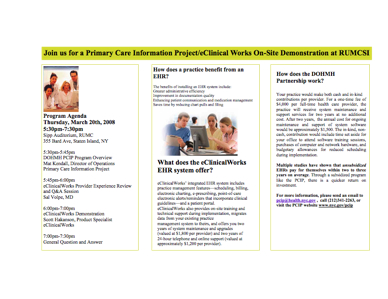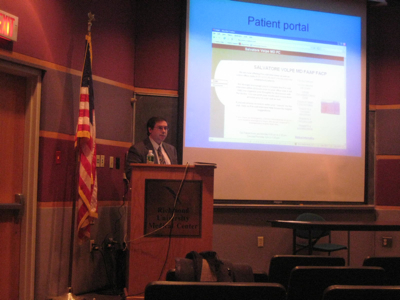When I found out that Sal Volpe, MD, Mat Kendall, and the PCIP team were going to be talking about their work in the community where Sal practices, I knew I wanted to come and experience it.

We started with Sal allowing me to experience the trip from Manhattan to Staten Island, which can take up to 2 hours by car as it did this day. This says something about Sal’s commitment to this work. He makes this commute regularly to support New York in rolling out this program, at the same time he supports his family and Internal Medicine/Pediatrics/Geriatrics practice on Staten Island. On the way over, he told me how the electronic health record has changed things for him. Prior to having an EHR, he used to take his sons for a walk to his office, where he would catch up on charts for a bit, and then walk with them home. Since that time, they don’t have to stop at the office anymore – they just walk longer together. This is not to say that the EHR has reduced the workload, it has allowed Sal to integrate it better with his family.
We arrived at Richmond University Medical Center and began with an overview of the PCIP program by Mat Kendall, the Director of Operations. It really is impressive to think that here is a Department of Health actively engaged and interested in community providers having better tools to take care of patients first.


Sal then came on and presented his experience, and I think his experience is important, given that he manages his own practice and accepts the risk of the business decisions he makes. With the data showing that EHR’s are more prevalent in group practices, Sal’s story is important in the conversation. He included his experience with the patient portal that comes with the system he uses, which is manufactured by eClinicalWorks. He then spoke about the fact that since he turned on the system, he has given every patient a copy of his physician’s progress note. When asked about this, he said, “What’s wrong with giving them a copy?” I thought that was a great question to ask of all physicians everywhere.
I was given a ride back by Mat Kendall and the rest of the PCIP team. Spending time with Mat reassures me that optimism is infectious – usually I am the most optimistic person in the room but when I am around Mat, this is not the case. It’s always nice for me to have optimism radiated in my direction. We had a nice conversation about the future of the program and of the patient portal in it. Mat has 4 years’ worth of experience managing a Federally Qualified Health Center, so he has a good idea about how to be successful with patient access, and I believe him. Despite the challenges of a visit-based reimbursement model, there’s the idea that patient access will improve access to good health care and promote better use of the system among patients who do not know their risks. Mat also points out that the data to date about visit reduction comes from commercial health plan settings. The PCIP team is well aware of data about Internet use in the population it serves and the potential benefit from giving them access to data contained in EHR systems. Right on.
I left the conversation and the evening as optimistic as I ever have about patient access to health information technology. Before I started this journey, I didn’t forsee that one of the most innovative practices I would discover would be in Staten Island, NY, or that a Department of Health could steward health information technology adoption for a whole community. I did and they are.